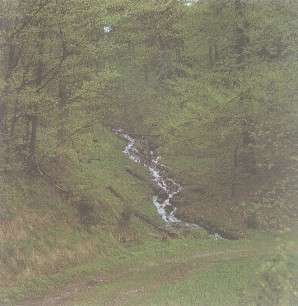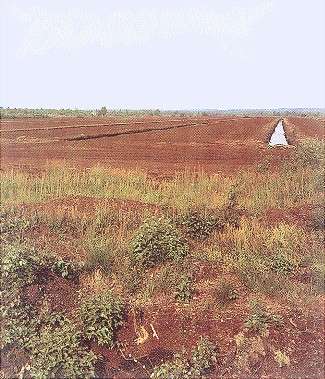Influence of Man on Soil Conditions
![]()
 Agricultural activities
(and partially forestry) as well as non-farming activities influence
soil conditions. Agriculture, apart from improving the properties
and fertility of soils, may in some cases cause degradation. The
most dangerous are the processes of soil erosion. Admittedly,
water and wind erosion are natural geomorphologic processes, yet
the farming of land, mainly ploughing, visibly speeds up these
processes. It is estimated that about 39% of the territory of
Poland is tHReatened by water erosion and about 28% by wind erosion.
Intensive and moderate water erosion tHReatens about 16% of the
territory of Poland. It affects mainly the mountains and mountainous
terrain but also the highlands. Moderate erosion tHReatens large
areas of the lake districts. Among the areas tHReatened by potential
(intensive and moderate) erosion, 50ñ60% of the ground
is actually undergoing active surface erosion, where clear signs
of soil degradation are visible. It affects about 8ñ10%
of the total acreage of ploughland. Weak potential erosion tHReatens
about 18% of the territory of Poland. Active weak erosion occurs
on much smaller areas and affects about 10% of ploughlands. Erosion
of such degree of intensity does not cause overly large degradation
of the soil and it can be limited by agrotechnical measures. On
the other hand, terrain undergoing moderate and strong erosion
should be cared for specially for example, by changing the utilization
structure and cultivating across the hill-sides.
Agricultural activities
(and partially forestry) as well as non-farming activities influence
soil conditions. Agriculture, apart from improving the properties
and fertility of soils, may in some cases cause degradation. The
most dangerous are the processes of soil erosion. Admittedly,
water and wind erosion are natural geomorphologic processes, yet
the farming of land, mainly ploughing, visibly speeds up these
processes. It is estimated that about 39% of the territory of
Poland is tHReatened by water erosion and about 28% by wind erosion.
Intensive and moderate water erosion tHReatens about 16% of the
territory of Poland. It affects mainly the mountains and mountainous
terrain but also the highlands. Moderate erosion tHReatens large
areas of the lake districts. Among the areas tHReatened by potential
(intensive and moderate) erosion, 50ñ60% of the ground
is actually undergoing active surface erosion, where clear signs
of soil degradation are visible. It affects about 8ñ10%
of the total acreage of ploughland. Weak potential erosion tHReatens
about 18% of the territory of Poland. Active weak erosion occurs
on much smaller areas and affects about 10% of ploughlands. Erosion
of such degree of intensity does not cause overly large degradation
of the soil and it can be limited by agrotechnical measures. On
the other hand, terrain undergoing moderate and strong erosion
should be cared for specially for example, by changing the utilization
structure and cultivating across the hill-sides.
 Apart from surface
water erosion, gully erosion sometimes occurs causing strong degradation
of soils. The regions with varied surface features are most exposed
to gully erosion. It affects the Eastern and Central Beskidy Mountains,
Wyzyna Lubelska together with Roztocze, as well as the eastern
and central part of the Pogorze Srodkowobeskidzkie, Niecka Nidzianska,
eastern part of the Wyzyna Kielecko-Sandomierska and the southern
part of Wyzyna Slaska. The total length of gullies in Poland is
34,500 kilometres, while the total acreage is 86,000 hectares.
A large part of the gullies are old, usually reforested or overgrown
with sod. Some gullies are active and systematically degrade the
adjoining terrain. The existence of loess and loessic soils, dust-clay
soils, varied land surface features and reinforced dirt roads
running along the fall of the land are factors aiding the growth
of the existing gullies and the creation of new ones.
Apart from surface
water erosion, gully erosion sometimes occurs causing strong degradation
of soils. The regions with varied surface features are most exposed
to gully erosion. It affects the Eastern and Central Beskidy Mountains,
Wyzyna Lubelska together with Roztocze, as well as the eastern
and central part of the Pogorze Srodkowobeskidzkie, Niecka Nidzianska,
eastern part of the Wyzyna Kielecko-Sandomierska and the southern
part of Wyzyna Slaska. The total length of gullies in Poland is
34,500 kilometres, while the total acreage is 86,000 hectares.
A large part of the gullies are old, usually reforested or overgrown
with sod. Some gullies are active and systematically degrade the
adjoining terrain. The existence of loess and loessic soils, dust-clay
soils, varied land surface features and reinforced dirt roads
running along the fall of the land are factors aiding the growth
of the existing gullies and the creation of new ones.
Significant changes in the natural environment, including changes of the soil cover are a result of water system disturbance by people. Many soils have undergone deep transformations under the influence of reclamation. The smallest, and in majority favourable changes resulting from reclamation happened in the ploughland. Correctly performed reclamation removes the defections in these soils while only slightly disturbing the water system. It is a different matter in case of greenland reclamation (often drying of marshes). Peat bogs are an important element to the geographical environment because of their specific natural properties determined by physiographical elements, such as location, water conditions and floral properties. In Poland, marshy soils and post-marsh soils occupy about 2,600,000 ha, half of which are peat bog and peat bog-marsh soils (TABLE ñ with information on the utilization of peat bogs).
The utilization of land for agriculture (meadows) depends upon prior regulation (drainage) of the peat bogs. A result of this is a process during which peat bogs turn into marshes and mineralize. This is followed by the loss of soil mass, which causes these soils to become more and more shallow until they are completely gone. The pace of these changes depends upon the climatic conditions and the degree (depth) of drainage. In Poland, the pace of the annual lowering of meliorated areas of peat bog deposits is about 1 cm per year. With excessive overdrying and meadow utilization of the fields this pace is 1.3 to 1.5 cm, while in case of vegeTABLE cultivation these areas sink 3 cm per year.Large changes of hydrological conditions (excess or lack of water) are caused by the mining industry and the utilization of deep waters for industrial and municipal purposes. This worsens the water conditions of the soils and often leads to their degradation (an example of this is the region of the strip-mine "Belchatow").
Soil chemical degradation is caused by chemical elements introduced by many pollutant sources, mainly industrial emissions of gasses and dusts.Anionic elements such as nitrogen, sulphur, fluorine and boron are not retained in the soil. They are dissolved in soil solution and transported inside of the soil causing its acidification. The degradation of the soil by these elements can be determined on the basis of the degree of acidification of the soils and the extent of changes related to this process. As it was mentioned before, in the soil cover of Poland a large area has light and very light soils, which are naturally acidic. Their original acidification was a result of the natural soil creation process. In the last decades the process of acidification of the soils has intensified. In the case of farmland, it was caused to some extent by increased dosages of mineral fertilizer, some of which are acid salts. And yet the largest share of contamination is due to gaseous pollution of the air by sulphur dioxide and nitrogen oxides. This contamination reaches the plant cover in the form of acid rain and dry deposits. On the average, 200 kg of sulphur dioxide is deposited on one hectare each year, which results in a quick process of soil acidification. The latest studies show that 60% of farmland (61% of ploughland and 52% of grassland) have an acidic reaction. Soils that are very acidic should be considered chemically degraded. The acidification accelerates many processes which lead to the depletion of base ions (calcium, magnesium, potassium) from the soil and freeing of elements harmful to plants (aluminium, manganese) as well as acceleration of the mobility and availability of heavy metals to plants. The prevention of soil acidification is based upon systematic liming (every four years). It should be mentioned that in the 1980s 2.5 to 3 million tonnes of CaO in lime fertilizers were used annually for liming soil. Studies of soil acidity done at the same time did not show any change in the reaction of the soil. This means that such an amount of lime is washed away each year from our soils into ground and surface waters. Thus, to maintain the fertility of Polish ploughland at a present level, it is necessary to regularly lime the farmland with proper dosages (on average 200 kg CaO per year).
In some regions of the country, particularly in the south and southwest, large areas of soil have undergone chemical degradation as a result of excessive accumulation of trace elements in the surface layers. Smaller areas in other regions of the country also degraded in this way. The most important source of soil contamination by these elements is the deposition of dusty pollutants from the atmosphere, coming from industrial emissions. Currently, we should take into account the risk of contamination of the soil by the following elements: cadmium, lead, zinc and copper. Contamination by mercury, nickel, cHRomium, boron and other elements takes place depending on the type of industrial production in the area. The current examination of the contents of trace elements in the soil shows that over 95% of the acreage of farmland contains such amounts of these elements considered to be natural. About 4% of the farmland contains higher amounts of heavy metals. This can be qualified as weak contamination. The total acreage of farmland that qualifies as chemically degraded (to a different degree) is about 150,000 ha, that is, less than 1% of the area of farmland. Areas contaminated to such a degree that farming can no longer be done upon them are not larger than 60,000 ha (excluding the so-called safety zones around the factories). The largest area of the most contaminated soils is Katowice voivodship, especially the Upper-Silesian Industrial District.